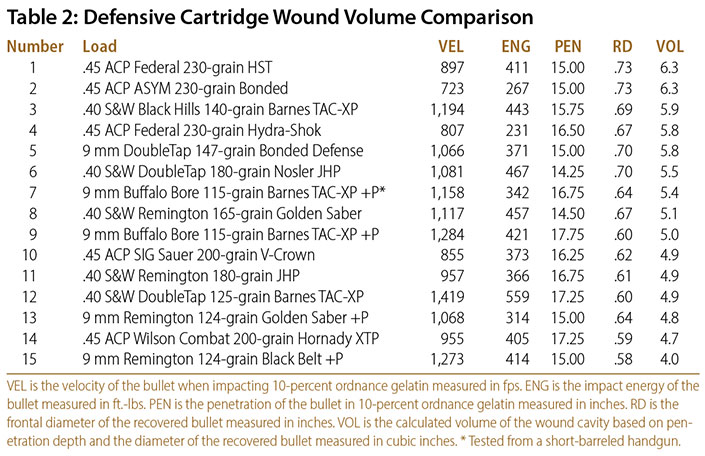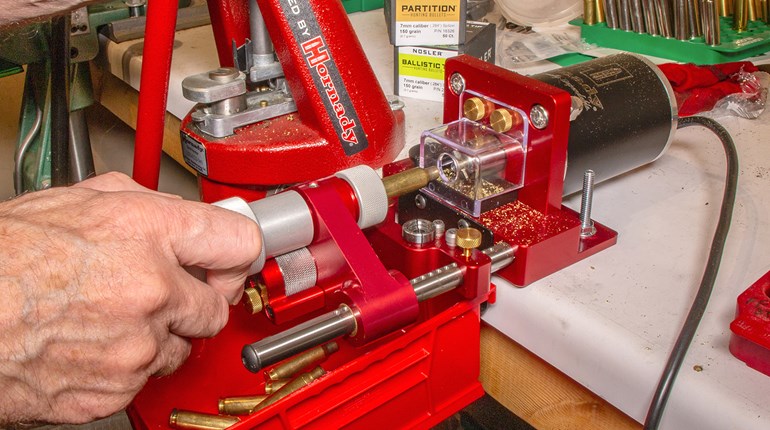
What’s the best handgun cartridge or caliber? I almost hate to open this can of worms due to the urban legends, misconceptions and delusions surrounding the topic. Many gunwriters, defensive trainers and Internet experts have proclaimed they know the answer. I suspect a lot of this is partly due to a need to boost egos, and partly because humans think there must always be a “best.”
When it comes to defensive-handgun cartridges and ammo, I have preferences and biases. But, I also acknowledge when it comes to stopping a bad guy with a handgun there are no absolutes. You cannot predict with any certainty how fast incapacitation will occur. Sure, central nervous system and spinal hits should be immediate and sometimes a hit anywhere is enough to change a felon’s mind. The problem is, there’s no guarantee of getting the former, and the latter might not incapacitate.
If we accept blood loss as the only sure way to bring about incapacitation, let’s take a different approach to the matter. A felon who bleeds enough will lose consciousness and cease all felonious activities. Hand-gun bullets perpetuate bleeding through tissue damage, which is caused by the hole a bullet creates. We’ve all seen photos of gel blocks and the destruction created inside. Many believe the radiating stress cracks caused by handgun bullets are not created with enough force to increase trauma. This may or may not be true, so let’s go with the hole we know.
If a bullet expands to a diameter of .50 inch, and penetrates 15 inches deep, we could reasonably assume it has damaged a cylinder of tissue equating to a volume of about 3 cubic inches. (The volume of a cylinder equals π r2 h.) Logic would seem to dictate the bullet creating the most destruction would produce the most pain, create the most vital-organ disruption, and produce the most rapid blood loss. Whether talking about gold, chocolate pie or damaged tissue inside an attacking criminal, any logical person would want the most they could get.
For comparison, I took the best five 9 mm, .40 S&W and .45 ACP loads I’ve tested and compared the volume of the wounds they were capable of making, based on penetration depth and expanded bullet diameter. To keep the playing field level, I compared loads penetrating to near the same depth: between 14 and 18 inches. In other words, for every 17-inch penetrating 9 mm load, I tried to find a 17-inch penetrating .40- and .45-caliber load.
 Table 1 lists the penetration and wound-cavity volume for the loads in the study, but it’s devoid of commonly compared numbers like velocity, bullet weight, and energy. You’ll also notice the cartridge and load specifics are not listed. Why is data excluded? To keep biases from creeping in. This way you can absorb the results free of preconceived notions. To see the actual loads and additional information corresponding to them, see chart below.
Table 1 lists the penetration and wound-cavity volume for the loads in the study, but it’s devoid of commonly compared numbers like velocity, bullet weight, and energy. You’ll also notice the cartridge and load specifics are not listed. Why is data excluded? To keep biases from creeping in. This way you can absorb the results free of preconceived notions. To see the actual loads and additional information corresponding to them, see chart below.
The results were both enlightening and predictable. The 9 mm loads averaged a wound volume of 5.0 cubic inches. Or, the hole created would hold about 2.77 fluid ounces. The average wound volume for the .40 S&W loads was 5.3 cubic inches (2.94 fluid ounces) and the .45 ACP loads averaged 5.6 cubic inches (or 3.10 fluid ounces.)
To simplify, let’s look at the data another way. The extreme wound-cavity volume variation between the 9 mm and the .45 ACP is about half a cubic inch or a third of an ounce. Even though it equates to about 10 percent more volume, that’s not much difference at all. It’s less than a half-dose of cough syrup and about the same as a quarter of a shot of your adult beverage of choice (or 1.2 U.S. fluid ounces).
The unsurprising part is that, on average, a .40-caliber bullet makes a 6-percent-larger hole than a 9 mm bullet, and a .45-caliber bullet makes a 6-percent-larger hole than a .40-caliber bullet. On average, the caliber of the unfired bullet is linearly equivalent to the size of the hole it might make. A .40-caliber bullet is 11 percent larger in diameter than a 9 mm projectile and a .45 caliber bullet is 11 percent larger than a .40-caliber one.
Aside from how big a hole you want, just as important is how deep you want it to be. You cannot have deep penetration and wide expansion, because defensive-handgun cartridges must divide their energy between the two. Therefore, you either have a balance or a lot of one and a little of the other. With regard to wound- cavity volume, a 10 percent increase in expansion will increase the cavity volume by twice as much as a 10 percent increase in penetration. But, without sufficient penetration, none of this really matters.
So, which personal-defense cartridge is best? When it comes to terminal performance, there’s less than a dose of cough syrup difference between the 9 mm, the .40 S&W and the .45 ACP. If we only consider the size of the hole, the best defensive-handgun cartridge is probably best described as the one that fits the defensive handgun you can afford, shoot well and carry most frequently. They all make holes that are nearly the same size.





































